HF datalink provides long-range communication using high-frequency radio waves, ideal for beyond-line-of-sight connectivity in remote or maritime environments. SATCOM offers reliable satellite-based communication with higher data rates and global coverage, enhancing Your ability to maintain continuous, secure connections regardless of terrain or distance.
Table of Comparison
| Feature | HF Data Link | SATCOM |
|---|---|---|
| Communication Range | Global, via ionospheric reflection | Global, via satellites |
| Frequency Band | 3-30 MHz (High Frequency) | UHF, L, S, C, Ku, Ka bands |
| Latency | Higher due to ionospheric propagation | Low to moderate depending on satellite type |
| Data Throughput | Low to moderate (typically up to 56 kbps) | High (up to several Mbps or more) |
| Reliability | Weather and atmospheric conditions sensitive | Highly reliable with redundancy options |
| Infrastructure | Ground stations and radio equipment | Satellite constellations and ground terminals |
| Use Cases | Over-the-horizon communication, maritime and remote areas | Real-time voice, video, data over vast regions |
| Cost | Lower initial and operational costs | Higher cost due to satellite deployment and leasing |
Introduction to HF Datalink and SATCOM
HF Datalink uses high-frequency radio waves to provide reliable, long-range communication primarily for aircraft and maritime operations, operating effectively beyond line-of-sight without satellite dependence. SATCOM relies on satellites to enable global, high-speed voice and data transmission, offering seamless connectivity especially in remote or offshore locations. Understanding your operational environment helps determine whether HF Datalink's cost-effective, widespread coverage or SATCOM's high-bandwidth, global reach best suits your communication needs.
Core Principles of HF Datalink
HF datalink operates by transmitting data over high-frequency radio waves, enabling long-range communication beyond the line of sight without relying on satellites. It utilizes ionospheric reflection and skywave propagation to maintain connectivity, ensuring resilience in environments where satellite communication (SATCOM) may be compromised. Your choice between HF datalink and SATCOM depends on mission requirements for range, reliability, and susceptibility to jamming or environmental interference.
Basics of Satellite Communication (SATCOM)
Satellite Communication (SATCOM) uses satellites orbiting the Earth to relay signals, enabling long-distance, high-bandwidth data transmission unaffected by terrain or distance limitations common in HF datalink systems. SATCOM supports real-time, global connectivity with low latency, making it ideal for critical operations requiring reliable communication channels. Your choice between HF datalink and SATCOM depends on the need for coverage area, data rate, and signal reliability in various operational environments.
Key Differences: HF Datalink vs SATCOM
HF Datalink operates on high-frequency radio waves allowing long-range, beyond line-of-sight communication primarily used for aircraft and maritime data exchange, while SATCOM relies on satellite networks providing global coverage with higher bandwidth and lower latency. HF Datalink is cost-effective and resilient in remote areas without satellite infrastructure but is susceptible to atmospheric interference and slower data rates compared to SATCOM. SATCOM supports real-time voice, video, and data communication essential for modern military, commercial aviation, and offshore operations.
Coverage and Reliability Comparison
HF datalink provides extensive coverage over vast oceanic and remote areas using skywave propagation, making it ideal where satellite visibility is limited. SATCOM offers superior reliability with consistent, low-latency communication through satellite constellations, particularly effective in urban and high-latitude regions. Your choice depends on mission requirements, balancing HF's broad reach against SATCOM's dependable signal quality.
Data Transmission Speeds and Capacity
HF datalink typically offers lower data transmission speeds ranging from 1200 to 9600 bps, making it suitable for voice and low-rate data communications over long distances without satellite reliance. SATCOM provides significantly higher data rates, often exceeding several Mbps, enabling high-capacity transmissions for broadband applications and real-time video communications. The capacity difference stems from SATCOM's use of higher frequency bands and advanced modulation techniques, supporting larger bandwidth allocations compared to HF's limited spectrum and propagation constraints.
Security and Interference Risks
HF datalink systems offer encrypted communication but are more vulnerable to interception due to predictable frequency patterns and lower bandwidth, increasing security risks. SATCOM provides stronger encryption protocols and frequency hopping techniques, significantly reducing interference and eavesdropping chances. However, SATCOM can be susceptible to jamming and signal degradation from solar activity or physical obstructions, impacting overall reliability.
Operational Costs and Infrastructure
HF datalink systems typically incur lower operational costs due to their reliance on established ground-based transmitters and minimal satellite usage, reducing the need for expensive orbital infrastructure. SATCOM requires significant investment in satellite deployment, maintenance, and ground stations, leading to higher upfront and ongoing expenses. Your choice depends on balancing budget constraints against the need for global coverage and real-time connectivity.
Use Cases in Aviation and Maritime Industries
HF datalink provides reliable long-range communication in remote oceanic and polar regions for both aviation and maritime industries, ensuring safety and coordination where satellite coverage is limited or unavailable. SATCOM offers high-speed data transmission and global connectivity essential for real-time weather updates, flight tracking, and emergency communications on commercial aircraft and vessels operating in heavily trafficked routes. Together, these systems enhance situational awareness and operational efficiency by complementing each other's coverage and reliability in diverse environments.
Future Trends and Technology Advancements
HF datalink technology is evolving with enhanced adaptive modulation and advanced error correction techniques to improve range and reliability in contested environments, enabling secure beyond-line-of-sight communication. SATCOM advancements emphasize higher throughput with LEO and MEO satellite constellations, low latency, and AI-driven beamforming to optimize bandwidth allocation and resilience against jamming. Integration of HF datalink with SATCOM terminals through software-defined radios and multi-network orchestration platforms is accelerating, promoting seamless interoperability and dynamic spectrum management for next-generation military and commercial communication systems.
HF datalink vs SATCOM Infographic

 libmatt.com
libmatt.com